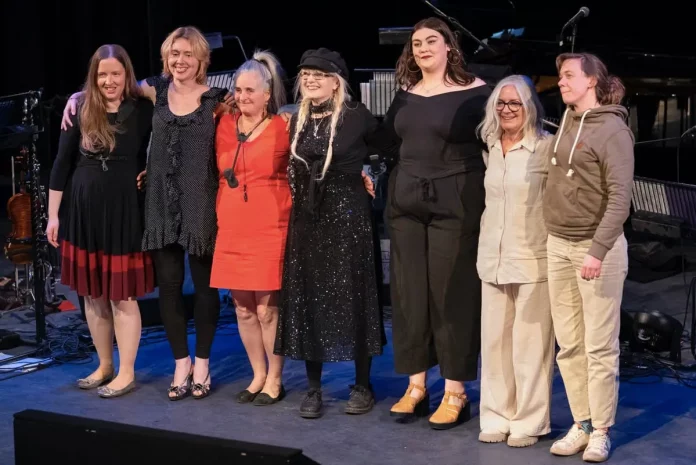
Undeniably there was a point to be made about the final element of Archwilwyr Jazz Explorers, the year-long, all-Wales jazz project focusing on community, education and diversity and aimed at developing work opportunities for Wales-based jazz musicians. And it was this: women still struggle to make headway in the jazz world, though things have improved a lot, so here was a demonstration of what they say the male-orientated jazz business is missing.
A super seven-piece distaff band that included bassist Paula Gardiner, head of the jazz course at the Royal Welsh College of Music and Drama, and drummer and percussionist Liz Exell, a member of her staff, also featured multi-instrumentalist Deborah Glenister, violist and clarinettist Maria Lamburn, violinist Xenia Porteous and vocalists Siobhan Ellen Waters and Jane Williams (the latter also doubling piano and ukulele).
It was a sold-out gig, organised by Black Mountain Jazz at the newly refurbished Borough Theatre. There were exhibits from Jazz Heritage Wales’s compendious collection of memorabilia at University of Wales Trinity St David and seven short biographical films by Mark Viveash’s 47 Studios & Productions for each member of the band, screened as they played. Original compositions and jazz standards by women musicians made for an event directed at the audience from different angles.
Considering the didactic nature of the project and the musicians’ relative lack of familiarity with each other as a group, the sonorities employed were fresh and unexpected. Lamburn on viola and Porteus on violin proved to be a melting combination and when Lamburn switched to bass clarinet with violinist Porteous and Glenister on clarinet for The Honeybee, a jolly number, their trio sound was just so. Lamburn’s We Are The Water employed the same trio combination with sussurating aqueous sounds. Just as bouncy was Porteous’s Saturday Sundae, a chart reflecting her interest in folk and gypsy jazz.
Lamburn’s folk-inspired background contrasted with Williams’ theatrical one, though she (Williams) joined her first jazz band at 18. Her Lylabai (Lullaby) saw the strings-woodwind trio this time giving the proceedings a jazz-meets-cabaret feel, and her heartfelt version of Autumn Leaves, with Gardiner switching to guitar and Porteous joining in, extended the vocal power and range already demonstrated by her and Waters in the opening Roll Jordan Roll. Gardiner reminded the audience that the latter was sung by the all-black Fisk Jubilee Singers on a 19th-century visit to Swansea from Nashville.
Waters, a jazz vocals specialist, draws on other genres and is a songwriter to boot, sharing Willow Weep For Me with Williams, Glenister’s tenor sax and the violin-viola duo, and swinging along proprietorially on her Same Four Walls. An arrangement of Gardiner’s In The Garden accompanied her film. Also catching the ear with their sparkle and originality were Glenister’s Dusk And Daybreak and Lamburn’s Taith Amser (Time Travel).
Exell drew on a London metropolitan provenance that gave her drumming the authority on which the band could stretch out. Her Hello Goodbye, with its almost random bass-drum beats and varied taps was manifestly a drummer’s composition; it prompted pizzicato from Lamburn and a splendid vocal by Waters. Exell, by accident or design, was left in her film to make the all-important points about women in music historically missing out. Gardiner accompanied the film about herself on recorder and guitar and gave concluding fizz with two original numbers that kept everyone alert, not least in a tricky, rap-inspired encore skilfully navigated by Waters and the rest.
Porteous had remarked on how cool it was that the band should be accompanying screened film as in the cinemas of yesteryear. Cool enough. But some might say not as cool as the sight of women musicians standing up for an equality of opportunity denied to many of their forebears.















